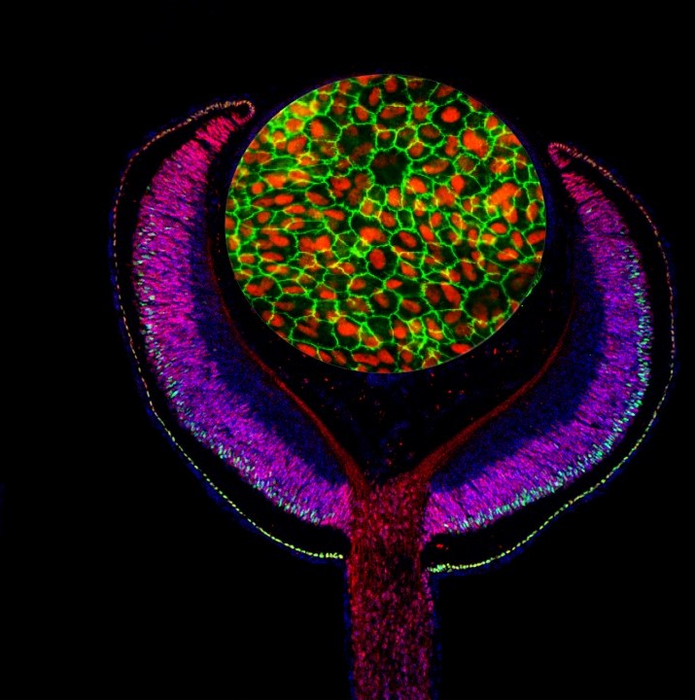Scientists headed by a team at Tel Aviv University have combined a map of gene regulatory sites with disease-associated loci to uncover a new genetic risk factor for age-related macular degeneration (AMD). The work, led by Ran Elkon, PhD, and Ruth Ashery-Padan, PhD, adds new insight into factors that underlie this key cause of visual impairment in adults. Ashery-Padan commented, “The findings reveal a regulatory module consisting of LHX2 and OTX2 that controls the development and maintenance of the retinal pigmented epithelium, an important tissue of visual function.” The researchers reported on their study in PLOS Biology, in a paper titled, “The LHX2-OTX2 transcriptional regulatory module controls retinal pigmented epithelium differentiation and underlies genetic risk for age-related macular degeneration.”
AMD is the leading cause of irreversible visual impairment in older people, and accounts for about 50% of legal blindness in western countries, the authors commented. Susceptibility to AMD is related to a combination of genetic components and environmental factors. “Several genome-wide association studies (GWASs) have been applied to AMD, resulting in the identification of approximately 50 loci that are significantly associated with increased risk for this disease, the scientists noted. These AMD-associated loci contain over 1,000 candidate risk single nucleotide polymorphisms (SNPs). However, the team continued, “For most of these AMD loci, the causal variants, their mode of action, and the affected target genes are unknown.”
AMD is caused by dysfunction in the retinal pigmented epithelium (RPE), a layer of tissue sandwiched between the photoreceptors that receive light, and the choriocapillaris, which nourishes the retina. “In AMD, RPE dysfunction results in progressive accumulation of deposits, termed drusen, on the basal membrane of the RPE, which ultimately leads to hypoxia and choroidal neovascularization and/or progressive loss of RPE and photoreceptor cells,” the scientists explained. Because of the central importance of the RPE in AMD, the authors began by exploring a transcription factor—a protein that regulates specific genes—called LHX2 which, based on the team’s analysis of mouse mutants, is central to RPE development. Knocking down LHX2 activity in RPE derived from human stem cells, they found that most affected genes were down-regulated, indicating that LHX2’s role was likely that of a transcriptional activator, binding to regulatory sites on the genome to increase the activity of other genes.
The team’s studies indicated that one affected gene, called OTX2, collaborated with LHX2 to regulate many genes in the RPE. By mapping the genomic sites that OTX2 and LHX2 could bind to, they showed that 68% of those that bound LHX2 were also bound by OTX2 (864 sites in all), suggesting that they likely work together to promote the activity of a large suite of genes involved in RPE development and function. “The prevalent co-occupancy of OTX2 and LHX2 on many genomic sites suggests that they cooperate to ensure the activation of tissue-specific target genes,” the authors noted. “LHX2 and OTX2 are widely expressed in developing neural structures, where they play stage- and tissue-specific roles.”
A common method for finding genes that may contribute to a disease is to perform a genome-wide association study, which identifies SNPs that co-occur with disease. Numerous such studies have previously been carried out for AMD. However, a GWAS by itself cannot uncover a causal mechanism. Here, the authors compared their LHX2/OTX2 binding data to GWAS data in order to home in on variations that affected binding of the transcription factors, and thus may contribute to disease.
One such binding site was located within the promoter region of a gene called TRPM1, which had been previously linked to AMD, and found that the sequence variant at that site altered the binding strength of LHX2; the so-called C version bound it more strongly than the T version, and activity of the TRPM1 gene was higher when the C allele was present instead of the T allele.
The collective study results indicated that the previously known increased risk of AMD from the variant identified in the GWAS was due to reduction in binding of the LHX2 transcription factor to the TRPM1 gene promoter, with a consequent reduction in activity of this gene. The gene encodes a membrane ion channel, and previous studies had shown that mutations in the gene also cause visual impairment. “Through functional and genomic analyses, we reveal that LHX2 functions upstream and together with OTX2 on shared genomic regions (cistrome) in regulation of target genes. Through this feed-forward regulatory module LHX2-OTX2 control the RPE transcriptional program,” the team commented. “… by intersecting the identified LHX2-OTX2 cisregulatory map with published eQTL and ATAC-seq data from human RPE, we reveal a causal noncoding genetic variant for AMD and demonstrate that it acts by altering TRPM1 expression in the RPE through modulation of LHX2 binding to its promoter.”
They suggested that their study “exemplifies how delineation of tissue-specific transcriptional regulators, their binding sites across the genome, and their downstream gene-regulatory networks can provide insights into a complex disease’s pathology.”
Ashery-Padan added, “The genomic analyses further link the genomic regions bound by the two developmental factors to the genetics of the common, multifactorial blinding disease AMD.”
The authors further concluded, “Taken together, the reported cistrome of LHX2 and OTX2, the identified downstream genes and interacting co-factors reveal the RPE transcription module and uncover a causal regulatory risk SNP in the multifactorial common blinding disease AMD.”


